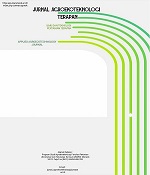PEST CONTROL Thrips sp. USING TRAP COLOR ON THE PLANTS of RED PEPPER (Capsicum annum L.)
DOI:
https://doi.org/10.35791/jat.v1i2.34071Abstract
Red pepper (Capsicum annum L.) is one kind of important vegetable that has high economic value and is suitable to be developed in tropical areas such as Indonesia. Pepper is largely used for household consumption and partly for export in the form of dry, sauce, flour, and others. Specifically in the Province of North Sulawesi, red pepper including one commodity crop of vegetables featured is the needs of the community of North Sulawesi chili is very high. The commodity cultivated on dry land both the highlands and the lowlands. Productivity of pepper plants can be reduced caused by the disruption of a variety of Plant pests (OPT), one of which is the insect pests of the Order Thysanoptera, family Thripidae, better known by the name of Thrips sp.
Keywords: Thrips sp., red pepper.
Â
Abstrak
Cabai merah (Capsicum annum L.) merupakan salah satu jenis sayuran penting yang bernilai ekonomis tinggi dan cocok untuk dikembangkan di daerah tropika seperti di Indonesia. Cabai sebagian besar digunakan untuk konsumsi rumah tangga dan sebagiannya untuk ekspor dalam bentuk kering, saus, tepung dan lainnya. Khusus di Provinsi Sulawesi Utara, cabai merah termasuk salah satu komoditi tanaman sayuran unggulan karena kebutuhan masyarakat Sulawesi Utara akan cabai sangat tinggi. Komoditi cabai banyak diusahakan di lahan kering baik dataran tinggi maupun dataran rendah. Produktivitas tanaman cabai dapat berkurang disebabkan oleh gangguan berbagai Organisme Pengganggu Tanaman (OPT), salah satunya yaitu serangga hama dari Ordo Thysanoptera, famili Thripidae atau yang lebih dikenal dengan nama Thrips sp.
Kata kunci : Thrips sp., cabai merah.
Downloads
Published
How to Cite
Issue
Section
License

This work is licensed under a Creative Commons Attribution-NonCommercial 4.0 International License.
















